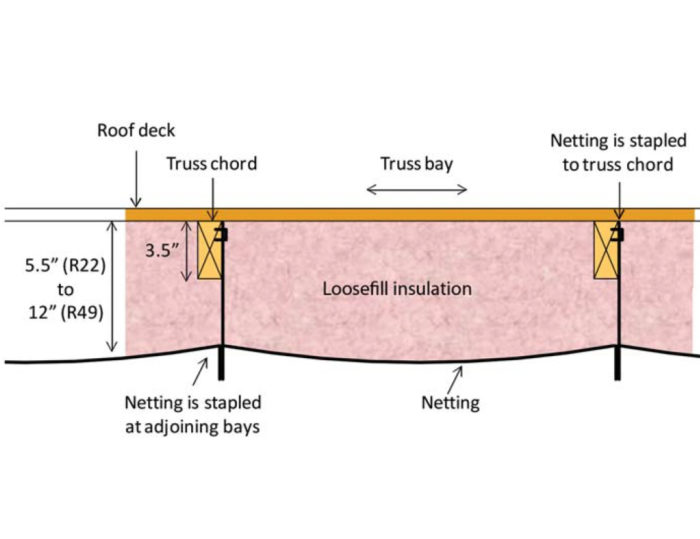
Image Credit: Images #1 thorugh #5: Owens Corning
UPDATED on August 31, 2018 with new information on code changes allowing the use of vapor diffusion ports.
Experts usually advise builders that you can’t install fiberglass insulation directly against the underside of roof sheathing. If you want to install fiberglass between your rafters, you have two basic choices: either include a ventilation channel between the top of the fiberglass insulation and the underside of the roof sheathing, or install enough rigid foam above the roof sheathing to keep the roof sheathing above the dew point during the winter. These rules were developed to prevent damp roof sheathing.
Most building codes (including the International Residential Code) allow just one exception to these rules: in Climate Zones 2B and 3B, you can install fiberglass insulation against the underside of your roof sheathing without a ventilation channel or rigid foam above the sheathing — but only if you install tile roofing. (This system works because concrete tiles and clay tiles are well ventilated and vapor-permeable, so any moisture that accumulates in the roof sheathing can dry toward the exterior.) The code exception can be found in section R806.5, subsection 5.2, of the 2012 IRC. (Of course, if the owner of such a home decides to re-roof with asphalt shingles, the roof sheathing may begin to rot. But that’s another story.)
Owens Corning, a leading manufacturer of fiberglass insulation, is now promoting a package of products — basically blown-in fiberglass insulation and a new type of insulation netting — to create unvented conditioned attics. Owens Corning calls this proprietary insulation method the “ProPink High Performance Conditioned Attic System.”
Surprisingly, Owens Corning is promoting this approach for unvented roof assemblies without any rigid foam above the roof sheathing. Does this make any sense?
This approach violates the code
Some Owens Corning documents include fine print warning builders that this…
Weekly Newsletter
Get building science and energy efficiency advice, plus special offers, in your inbox.

This article is only available to GBA Prime Members
Sign up for a free trial and get instant access to this article as well as GBA’s complete library of premium articles and construction details.
Start Free TrialAlready a member? Log in





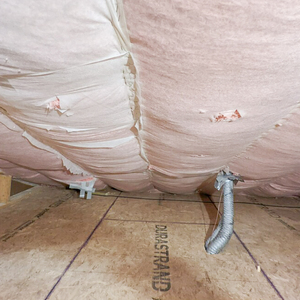
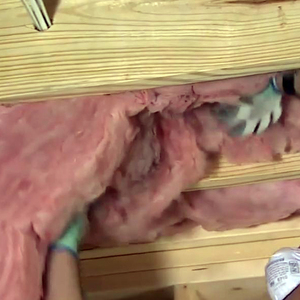
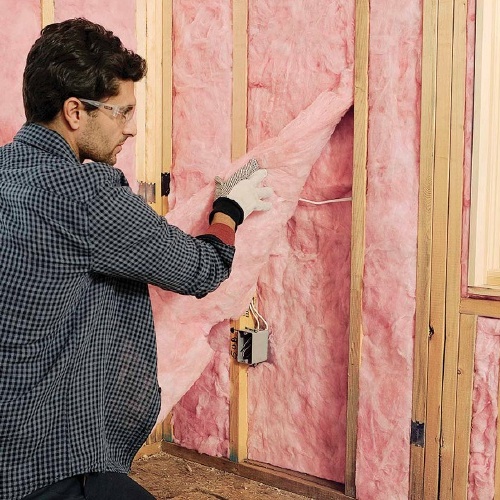
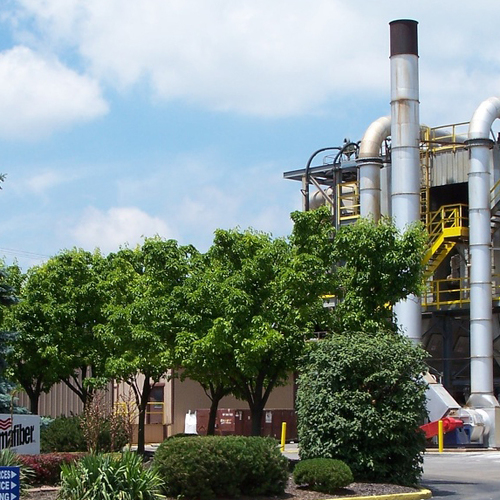






22 Comments
Extend this product into all climate zones w/ rigid foam above?
With rigid foam above the sheathing, this seems like an excellent solution for truss roofs in many climate zones. The old rules still apply: i.e. keep the sheathing warm and the air barrier defined.
The article "Calculating the Minimum Thickness of Rigid Foam Sheathing" (https://www.greenbuildingadvisor.com/blogs/dept/musings/calculating-minimum-thickness-rigid-foam-sheathing) includes a table of minimum thicknesses for unvented roof assemblies. For example, zone 4A & 4B require R-15 of rigid insulation directly above the sheathing. Combining this with this new Owens-Corning netting seems like an effective way to get to a high R-value roof in this application as well.
Response to David McNeely
David,
I agree with your analysis. The Owens Corning netting should prove useful to builders who install rigid foam above the roof sheathing and air-permeable insulation underneath (and in direct contact with) the roof sheathing.
Use in other climate zones w/additional vapor retarder
Achilles Karagiozis spoke at IBS in January about this product and about the use of air permeable insulation to create unvented attics in general. David, your suggestion is quite logical, but Achilles seemed to be suggesting that the use of this Owens Corning system would be applicable in other climate zones through the inclusion of alternative netting materials, specifically ones that also qualify as vapor retarders. I understand the concept he's going for, but don't necessarily see that as a complete solution. He did also mention the need to "achieve airtightness through other means", meaning not through the insulation material itself, but the applicability of this system in other climates is still a question mark (unless, of course, rigid foam is added).
Response to Brian Wolfgang
Brian,
You wrote, "Achilles seemed to be suggesting that the use of this Owens Corning system would be applicable in other climate zones through the inclusion of alternative netting materials, specifically ones that also qualify as vapor retarders."
This article address that issue in paragraph 9, which noted this Owens Corning recommendation: “For moisture control, Owens Corning requires the use of a vapor retarder in California Climate Zones 1, 2, 3, 11, 12, and 16. Owens Corning offers a version of the ProPink Boxed Netting that includes an integrated vapor retarder.”
You wrote, "He did also mention the need to ‘achieve airtightness through other means,’ meaning not through the insulation material itself." In fact (as this article notes) that need is an integral part of the Owens Corning instructions; the Owens Corning method uses the roof sheathing combined with canned spray foam to create an exterior air barrier.
You wrote, "the applicability of this system in other climates is still a question mark (unless, of course, rigid foam is added)." In fact, David McNeely's comment referred specifically to the use of this system in conjunction with rigid foam above the sheathing.
Vapour retarder netting
I'm having trouble visualizing how you would keep a continuous vapour retarder when it is going to be penetrated by the webs of all the trusses. The two dimensional diagram of the system avoids showing that intersection.
The manufacturer faces even more hurdles up here north of the border where our code takes an either/or approach to insulating above or below the roof sheathing.
Response to Malcolm Taylor
Malcolm,
Take a look at Image #4, which shows a completed installation. The visible fabric with the red letters on it is the insulation netting we're talking about; that netting is available in a version that had a low enough perm rating to be a vapor retarder.
I don't know why you are having trouble visualizing this layer as continuous. It certainly looks continuous to me -- much more continuous than is necessary for a layer to be considered an adequate vapor retarder.
Owens Corning makes no claim that this netting is an air barrier. The air barrier is elsewhere -- it consists of the roof sheathing and the canned spray foam used to seal leaks in the roof sheathing.
Penetrations by web truss members might be considered tricky to seal if this layer of fabric were intended as an air barrier. However, a vapor retarder that covers only 95% of the area in question is 95% as effective as one that covers 100% of the area.
.
What climate zones will this work in exactly?
Assuming the sheathing is an air-tight barrier, and using the vapor retarder version of this netting, this combination will work in CA climate zones that are equivalent to U.S. Climate Zones 3C, 4B & C, 5B and even a little of 6B. Are they saying that it will work without the exterior layer of foam in these climate zones, but as yet are not code-approved nationally?
Would not taped Zip sheathing qualify as an airtight barrier? Plywood sheathing with liquid-applied membrane, or ice & water shield?
So if I can convince my inspector that "Hey, it's good for CA, should be good here," and he or she agrees, I'll be able to dispense with the sheet foam and still sleep at night? What if I'm in a humid zone (e.g. 4A) but the house is very tight? What is the risk? If the sheathing did get damp, wouldn't it be able to dry to the interior?
Now this would really be a deal-changer for bringing the attic inside the envelope!
Response to David McNeely
David,
You wrote, "Assuming the sheathing is an air-tight barrier, and using the vapor retarder version of this netting, this combination will work in CA climate zones that are equivalent to U.S. Climate Zones 3C, 4B & C, 5B and even a little of 6B."
If you are correct, you are a bolder man than Achilles Karagiozis. For the time being, he said that Owens Corning is only endorsing this system for Climate Zones 2B and 3B. Outside of these zones, the company may choose to work with individual builders on a case-by-case basis. However, I don't know where you have gotten the information to reach your conclusion.
Q. "So if I can convince my inspector that 'Hey, it's good for CA, should be good here,' and he or she agrees, I'll be able to dispense with the sheet foam and still sleep at night?"
A. Perhaps. But if so, you are remarkably free of anxiety. I'm evidently a much lighter sleeper than you are.
In case my ironic tone is confusing, I'll be clear: I think that your conclusions aren't supported by my report.
Martin
You are probably right that it isn't as important that the netting be continuous as it is only designed to retard moisture not air, and perhaps installing it is easier that I think, but I'd like to see a photo that, unlike the neat installation they have provided, showed how you deal with the truss webs running from the bottom to the top chords.
Perhaps foolishly, most houses today aren't designed with identical pitched trusses, but have complex intersections, girder and mono trusses often with plywood overlays in the mix.
Martin,
Martin,
I really like your articles and they are always well-written. Here, you report two things that are "ironic and confusing" about the data sheet from Owens Corning; the second one is, "(2) the data sheet implies that this system can be used in some California climate zones that fall outside of DOE’s Climate Zones 2B and 3B." Specifically, it mentions CA zones 1, 2, 3, 11, 12, & 16. I looked here (http://www.energy.ca.gov/maps/renewable/building_climate_zones.html} to derive equivalent national climate zones.
I guess my question was really a request for clarification of this issue. It seemed by my reading that Achilles was using guarded language to limit any official recommendations to what they can support with research done; however, it seemed he was intimating that the limitation is the language of existing code, not the product itself, and that eventually a much broader application will be acceptable.
Malcolm's web query
Malcolm - I think you're letting Martin off the hook a bit too easily. The photo does not show where the webs drop down from the top chords, it shows only the chords. It would be exceedingly time consuming to make those junctions air or vapor tight.The air is carrying the moisture,and it is important, in all but the driest and warmest of climates.
Kevin.
With or without the webs, to me the system works against the inherent advantages of a trussed roof. Whether it's spray foam or this netting you are fighting against the characteristics of what as designed to be a large cavity, full of structural members, best insulated on the bottom.
Response to Malcolm Taylor (Comment #9)
Malcolm,
You make a good point that truss webs will complicate the installation of the netting. I don't think this issue has anything to do with vapor retarder effectiveness, though. Rather, it has to do with how difficult it will be for contractors to install the netting.
I'm not defending this system. In many ways, the argument in favor of exterior rigid foam insulation remains quite strong.
.
Response to David McNeely (Comment #10)
David,
You wrote, "My question was really a request for clarification of this issue."
Owens Corning's written materials describing this insulation are, indeed, confusing. However, Achilles Karagiozis's statements were not.
Any builder who wants to use this system probably wants to do so with the support of the manufacturer. (I doubt if any distributor is going to sell the netting to builders outside of Owens Corning's intended geographical regions, for one thing.) Any builder who tries to make inferences based on Owens Corning's poorly written documents, and to use those inferences to extend the use of this system to Climate Zones 4 or 5, would be nuts (in my view).
Climate zone maps are tricky. There is no way that you can pick a California climate zone (in a very dry area of the country) and pair that California climate zone with an area east of the Rocky Mountains, pretending that the climate zones are comparable. Humidity changes everything.
You wrote, "It seemed [that Achilles] was intimating that the limitation is the language of existing code, not the product itself, and that eventually a much broader application will be acceptable." I think that Achilles probably shares your hope that "a much broader application will be acceptable" -- eventually -- if the research results from current field trials are encouraging. But Owens Corning isn't there yet, and any use of this system in Climate Zone 4 or 5, if it ever becomes possible, may eventually includes significant additional elements like mandatory vapor diffusion vents at the ridge, or even mandatory rigid foam above the roof sheathing.
In the meantime, I hope that Owens Corning does a better job with their documentation, and cleans up the ambiguities and contradictions in their literature.
Response to Kevin Zorski (Comment #11)
Kevin,
You wrote, "It would be exceedingly time consuming to make those junctions air or vapor tight. The air is carrying the moisture, and it is important, in all but the driest and warmest of climates."
First of all, Owens Corning is only recommending this system in the areas of the U.S. that could be described as "the driest and warmest of climates." That limitation is there for a reason.
Second, Owens Corning is advising builders that the roof sheathing plane needs to be made airtight by sealing all seams and penetrations with canned spray foam. Whether or not builders in the field will find this an easy method of air sealing, and will fully comply with Owens Corning's directions, remains to be seen. But from the manufacturer's perspective, this air sealing work is an essential part of the installation work.
Owens Corning does not require the netting to be installed in an airtight manner. (If there is any doubt about this matter, check out the manufacturer's advice for plugging the holes in the netting that were created to insert the insulation blowing hose: "Plug any netting holes with a wadded piece of unfaced fiberglass batt insulation." See the illustration reproduced below, from the company's installation instructions.)
I tend to agree with scientists who say that, if the sheathing layer is airtight, you won't have air movement through the insulation, and you won't have any moisture problems in Climate Zones 2B and 3B.
The uncertainties, I think, have to do with (a) moisture of construction, (b) houses with elevated interior RH, and (c) whether or not builders will fully comply with the need to make the sheathing plane airtight.
.
Response to Malcolm Taylor (Comment #12)
Malcolm,
You wrote, "With or without the webs, to me the system works against the inherent advantages of a trussed roof. Whether it's spray foam or this netting, you are fighting against the characteristics of what is designed to be a large cavity, full of structural members, best insulated on the bottom."
I tend to agree with you. I think that this type of attic is best insulated on the bottom (if the attic is free of ducts and HVAC equipment), or with rigid foam above the roof sheathing (if the attic has ducts).
Truss Penetrations
The linked presentation shows more detail on the system's installation and how trusses are penetrated at the netting seams.
Installation Presentation
It would seem Owens Corning would want to offer more direct reasons why their system should be used over rigid, open or closed cell foam solutions. Instead their sell sheets mention "affordable" and "no quarantine" of the job site during installation.
rjp
It actually doesn't look that hard to work around the webs. Reservations about the whole idea of blowing fiberglass against the sheathing aside, the system has some smart details..
Response to RJP
RJP,
Thanks for posting those photos. They are useful for visualizing the way this system is installed.
The netting is not an air barrier
I saw this system at IBS and it was not clear there that is was only intended to be used in Climate Zone 2B and 3B. Thank you for that clarification. I still wonder about air permeable insulation not being encapsulated? It seems perrty clear that cavity insulation, which I believe this would be considered, should be encapsulated on all six sides. Code and Energy Star are pointing out that we are missing the interior air barrier in many locations and requiring that they be installed. Knee walls, behind tubs, shower pans, and fireplaces for example. In essence proper alignment of the air barrier and thermal barrier now defined as an interior and exterior air barrier system creating encapsulation of air permeable insulation on all six sides. Why do you believe OC does not see this as an issue.? A netting that is also a true air barrier to the attic side would make more sense to me in all climates.
Response to Robby Schwarz
Robby,
I agree with you that Owens Corning's marketing efforts don't make it clear that this insulation system is intended only for Climate Zones 2B and 3B. They need to do a better job of making that clear.
I also agree with you that it's always a good idea to encapsulate fiberglass insulation on all six sides. That need is reduced, however, when you have a very good top-side air barrier that prevents exfiltration, as Owens Corning recommends for this system.
I imagine that the fabric used in this system is an air barrier, but I didn't ask Achilles Karagiozis about its air permeance. Assuming that the fabric is an air barrier, it would probably be a good idea to tape the holes made to insert the insulation hose, and to tape the places where 2x4 truss webs penetrate the fabric -- but Owens Corning doesn't recommend those steps, presumably because they don't result in much of a performance improvement.
With Rigid Foam R-10 in Climate Zone 3A
Wow...despite the issues described above I think this could be the answer to my search. For new construction near Oklahoma City (Climate Zone 3A-needing R-30- R38 ceiling) I'm planning a real simple gabled roof. 10:12 pitch. I am planning on using engineered trusses with a 20 foot wide conditioned living space within the truss ...I was planning on the following profile: metal roof. nailers. 2" XPS rigid foam (R-10), osb sheathing, ........"fill in the blank" Perhaps this "high performance conditioned attic is a good solution for my project. Any comments? next step: Determine if I need to put some type of roof membrane down and where to put it (between which items?)
New to the forum..gonna post this as a question!
Log in or become a member to post a comment.
Sign up Log in